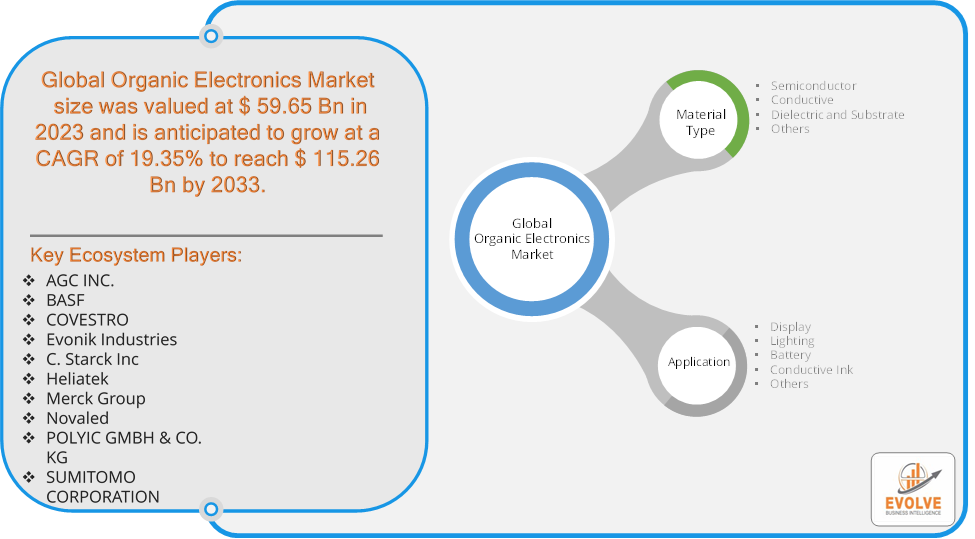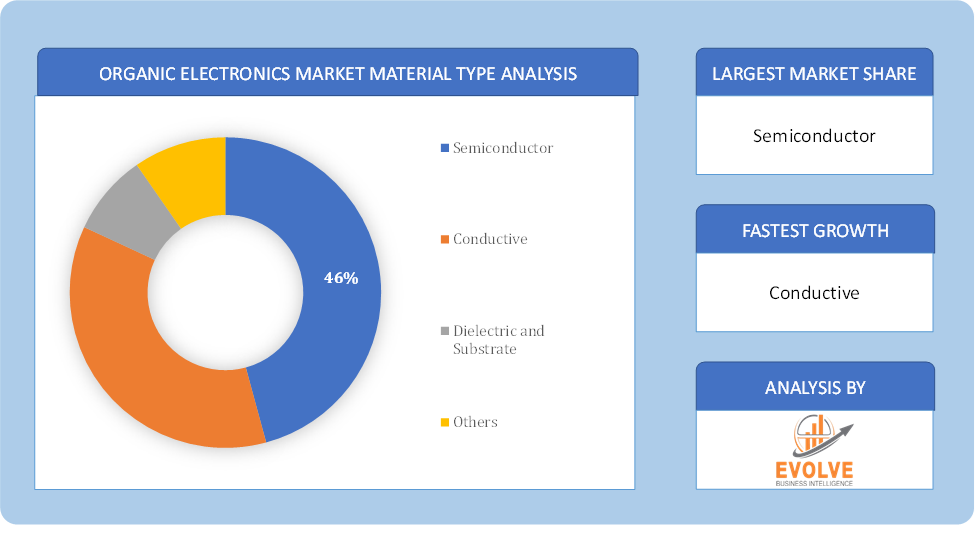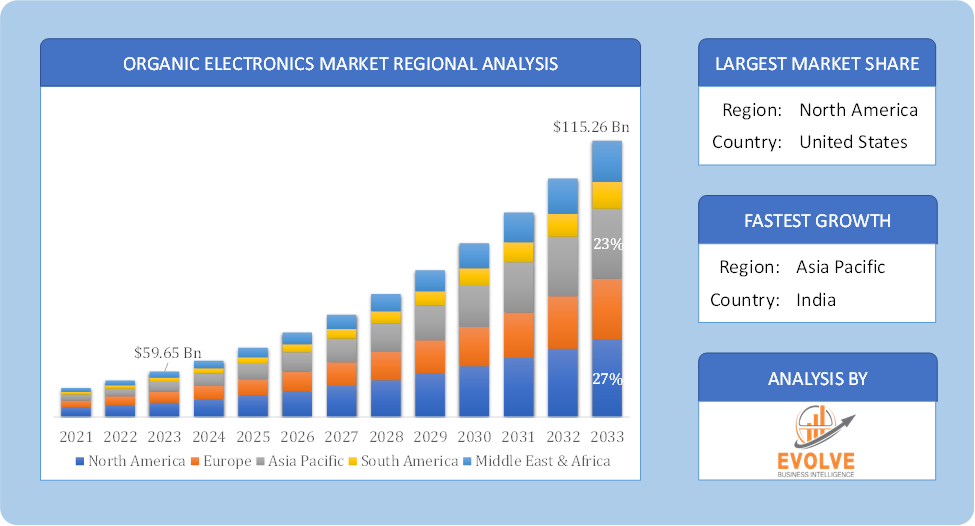Organic Electronics Market Analysis and Global Forecast 2023-2033
$1,390.00 – $5,520.00Price range: $1,390.00 through $5,520.00
Organic Electronics Market Research Report: Information By Material Type (Semiconductor, Conductive, Dielectric and Substrate), By Application (Display, Lighting, Battery, Conductive Ink, Others), and by Region — Forecast till 2033
Page: 165
[vc_row][vc_column width=”2/3″][vc_column_text text_larger=”no” woodmart_inline=”no”]
Organic Electronics Market Overview
The Organic Electronics Market Size is expected to reach USD 115.26 Billion by 2033. The Organic Electronics industry size accounted for USD 59.65 Billion in 2023 and is expected to expand at a compound annual growth rate (CAGR) of 19.35% from 2023 to 2033. The Organic Electronics Market refers to the sector that deals with electronic devices made from organic (carbon-based) materials, including polymers and small molecules. Unlike traditional silicon-based electronics, organic electronics offer advantages such as flexibility, lightweight construction, and the potential for low-cost manufacturing. These materials are used in a variety of applications, including organic light-emitting diodes (OLEDs), organic photovoltaic cells (OPVs), and organic field-effect transistors (OFETs). The market is driven by the growing demand for flexible and wearable electronics, energy-efficient displays, and advancements in organic material science.
Global Organic Electronics Market Synopsis
The COVID-19 pandemic has led to supply chain disruptions leading to supply shortages or lower demand in the organic electronics market. The travel restrictions and social-distancing measures have resulted in a sharp drop in consumer and business spending and this pattern is to continue for some time. The end-user trend and preferences have changed due to the pandemic and have resulted in manufacturers, developers, and service providers adopting various strategies to stabilize the company.
Organic Electronics Market Dynamics
The major factors that have impacted the growth of Organic Electronics are as follows:
Drivers:
- Rising Demand for Flexible and Wearable Electronics
The unique properties of organic materials, including their flexibility, lightweight nature, and the ability to be processed at low temperatures, make them ideal for use in flexible and wearable electronics. The increasing consumer preference for portable and wearable devices, such as smartwatches, fitness trackers, and flexible displays, is driving demand in this market. Organic electronics offer the potential to create innovative products that are not feasible with traditional rigid materials.
Restraint:
- High Production Costs for High-Performance Devices
Although organic electronics have the potential for low-cost production through techniques like roll-to-roll printing, achieving high-performance devices often requires more expensive and complex manufacturing processes. For example, the production of high-quality OLED displays involves intricate vacuum deposition techniques and stringent material purity requirements, which drive up costs. These high production costs can limit the competitiveness of organic electronics in price-sensitive markets, particularly when compared to more mature and cost-effective technologies.
Opportunity:
⮚ Expansion of Flexible and Wearable Technologies
The growing demand for flexible and wearable electronics presents a significant opportunity for the organic electronics market. Organic materials, with their inherent flexibility and lightweight properties, are ideal for creating devices that can be bent, stretched, and integrated into various forms, such as clothing, accessories, and even human skin. This opens up possibilities for a wide range of applications, including smart textiles, health monitoring devices, and flexible displays. As consumer interest in wearable technology continues to rise, organic electronics could play a key role in delivering innovative products that traditional rigid electronics cannot.
Organic Electronics Segment Overview
Based on Material Type , the market is segmented based on Semiconductor, Conductive, Dielectric and Substrate. the Semiconductor segment dominates, primarily due to its critical role in the performance and functionality of organic electronic devices, such as OLEDs and organic photovoltaics.
By Application
Based on Applications, the market has been divided into the Display, Lighting, Battery, Conductive Ink, Others. the Display segment dominates, driven by the widespread adoption of Organic Light-Emitting Diodes (OLEDs) in consumer electronics, particularly in smartphones, televisions, and wearable devices.
Global Organic Electronics Market Regional Analysis
Based on region, the global Organic Electronics market has been divided into North America, Europe, Asia-Pacific, the Middle East & Africa, and Latin America. North America is projected to dominate the use of the Organic Electronics market followed by the Asia-Pacific and Europe regions.
 Organic Electronics North America Market
Organic Electronics North America Market
North America holds a dominant position in the Organic Electronics Market. In terms of growth, North America held a significant proportion of the market for organic electronics. The area has advanced technology, and its early adoption of cutting-edge innovations like artificial intelligence (AI), machine learning, and the internet of things (IoT) contributed to its rise.
Organic Electronics Asia-Pacific Market
The Asia-Pacific region has indeed emerged as the fastest-growing market for the Organic Electronics industry. From 2023 to2032, the Asia-Pacific Organic Electronics Market is anticipated to expand at the fastest rate. This is because customers’ disposable money is increasing and the consumer electronics industry is consistently growing globally. Furthermore, the organic electronics market in China had the most market share, while the organic electronics market in India had the quickest rate of growth in the Asia-Pacific area.
Competitive Landscape
The global Organic Electronics market is highly competitive, with numerous players offering a wide range of software solutions. The competitive landscape is characterized by the presence of established companies, as well as emerging startups and niche players. To increase their market position and attract a wide consumer base, the businesses are employing various strategies, such as Material Type launches, and strategic alliances.
Prominent Players:
- AGC INC.
- BASF
- COVESTRO
- Evonik Industries
- Starck Inc
- Heliatek
- Merck Group
- Novaled
- POLYIC GMBH & CO. KG
- SUMITOMO CORPORATION
Key Development
May 2022: Evonik has started selling TAeTTOOz technology for printable rechargeable batteries to the InnovationLab GmbH. The InnovationLab specializes in the development of printed and organic electronics and offers individual overall solutions from the first concept draft to the industrial production.
Scope of the Report
Global Organic Electronics Market, by Material Type
- Semiconductor
- Conductive
- Dielectric and Substrate
- Others
Global Organic Electronics Market, by Application
- Display
- Lighting
- Battery
- Conductive Ink
- Others
Global Organic Electronics Market, by Region
- North America
- US
- Canada
- Mexico
- Europe
- UK
- Germany
- France
- Italy
- Spain
- Benelux
- Nordic
- Rest of Europe
- Asia Pacific
- China
- Japan
- South Korea
- Indonesia
- Austalia
- Malaysia
- India
- Rest of Asia Pacific
- South America
- Brazil
- Argentina
- Rest of South America
- Middle East & Africa
- Saudi Arabia
- UAE
- Egypt
- South Africa
- Rest of Middle East & Africa
| Parameters | Indicators |
|---|---|
| Market Size | 2033: USD 115.26 Billion |
| CAGR (2023-2033) | 19.35% |
| Base year | 2022 |
| Forecast Period | 2023-2033 |
| Historical Data | 2021 (2017 to 2020 On Demand) |
| Report Coverage | Revenue Forecast, Competitive Landscape, Growth Factors, and Trends |
| Key Segmentations | Material Type , Application |
| Geographies Covered | North America, Europe, Asia-Pacific, South America, Middle East, Africa |
| Key Vendors | AGC INC., BASF, COVESTRO, Evonik Industries, C. Starck Inc, Heliatek, Merck Group, Novaled, POLYIC GMBH & CO. KG, SUMITOMO CORPORATION. |
| Key Market Opportunities | · Eco-friendly technologies and their rapid adoption. |
| Key Market Drivers | · Growing demand for high-quality flexible electronics as well as advanced and high-performance semiconductors. |
REPORT CONTENT BRIEF:
- High-level analysis of the current and future Organic Electronics market trends and opportunities
- Detailed analysis of current market drivers, restraining factors, and opportunities in the future
- Organic Electronics market historical market size for the year 2021, and forecast from 2023 to 2033
- Organic Electronics market share analysis at each Material Type level
- Competitor analysis with detailed insight into its Material Type segment, Government & Defense strength, and strategies adopted.
- Identifies key strategies adopted including Material Type launches and developments, mergers and acquisitions, joint ventures, collaborations, and partnerships as well as funding taken and investment done, among others.
- To identify and understand the various factors involved in the global Organic Electronics market affected by the pandemic
- To provide a detailed insight into the major companies operating in the market. The profiling will include the Government & Defense health of the company’s past 2-3 years with segmental and regional revenue breakup, Material Type offering, recent developments, SWOT analysis, and key strategies.
[/vc_column_text][vc_column_text woodmart_inline=”no” text_larger=”no”]
Frequently Asked Questions (FAQ)
[sp_easyaccordion id=”74210″][/vc_column_text][/vc_column][vc_column width=”1/3″][vc_column_text text_larger=”no” woodmart_inline=”no”]
[html_block id=”3961″][/vc_column_text][vc_wp_text]
Press Release
[rpwe limit=”10″ thumb=”true”][/vc_wp_text][/vc_column][/vc_row]





